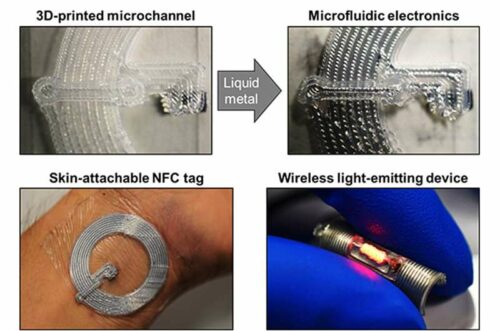This approach leverages advanced photopolymerisation and extrusion-based methods to fabricate fully automated, interconnected microfluidic devices with embedded functionalities, paving the way for more efficient and versatile microfluidic systems.

The transition from 2D to 3D microfluidic structures marks a significant advancement in microfluidics, enhancing scientific and industrial applications. These 3D systems increase throughput through parallel operation and enable the integration of microfluidics and electronics using soft elastomeric networks filled with conductive materials like liquid metal. Traditional methods, such as soft lithography fabrication requiring cleanroom facilities, struggle to achieve fully automated 3D interconnected microchannels. Manual procedures in these methods, including PDMS moulding and layer-to-layer alignment, limit the automation potential of microfluidic device production.
Current 3D printing technologies face two main challenges: directly printing interconnected multilayered microchannels without needing supporting materials or post-processing, and integrating electronic elements during the printing process. Researchers at the Singapore University of Technology and Design’s (SUTD) Soft Fluidics Lab have addressed these issues. 3D printing offers a promising alternative to traditional microfluidic fabrication methods. Techniques such as stereolithography apparatus (SLA) and digital light processing (DLP) enable the creation of complex microchannels through photopolymerisation. However, integrating electronic elements during light-based printing remains difficult. Extrusion-based methods like fused deposition modelling (FDM) and direct ink writing (DIW) allow for automated fabrication but struggle to print elastomeric hollow structures. The main challenge is developing an ink that is both soft enough for embedding components and robust enough for structural integrity, enabling the creation of fully printed, interconnected microfluidic devices with embedded functionalities.
Hollow Structures and Electronic Integration
The researchers optimised DIW 3D printing settings to create support-free hollow structures for silicone sealant, ensuring the extruded structure remained stable. They demonstrated the fabrication of interconnected multilayered microchannels with through-holes between layers, required for electronic devices like antennas for wireless communication. Integrating electronic components into microchannels during 3D printing is challenging with resins that cure immediately. The research team used gradually curing resins to embed and immobilise small electronic elements, such as RFID tags and LED chips. Self-alignment of these elements with microchannels enabled the self-assembly of components with electric wirings when liquid metal was perfused through the channel.
This technology addresses the need for 3D configurations of conductive wires, essential for electronic devices, which are difficult to achieve through conventional 3D printing methods. By injecting liquid metal into a 3D multilayered microchannel containing embedded electronic components, the SUTD research team facilitated the self-assembly of conductive wires, streamlining the fabrication of flexible and stretchable liquid metal coils.






